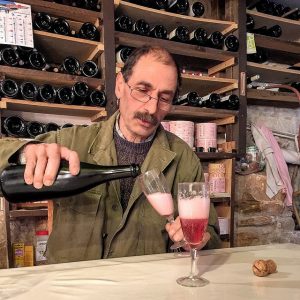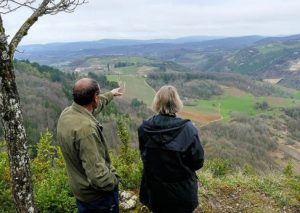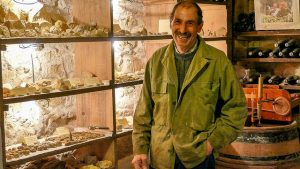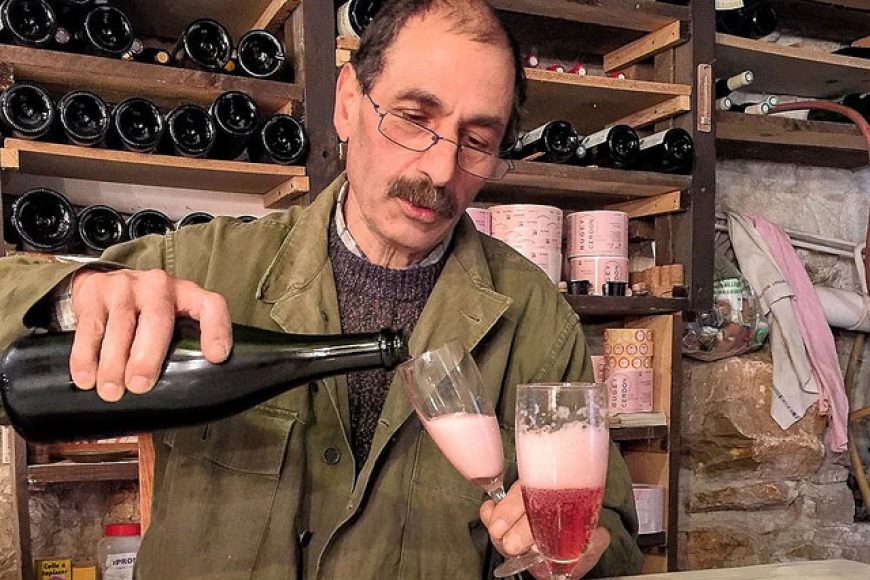Raphaël Bartucci – The Humble Star of Cerdon

Raphaël Bartucci serves a taste of his precious Cerdon ©Brett Jones
Meet Raphaël Bartucci: born of Italian immigrants, he was brought up in the Moselle region in eastern France. He collects fossils from the vineyards and displays them museum-style in the cosy tasting room below his house.
The following is an excerpt from the Northern Bugey section of Wines of the French Alps: Savoie, Bugey and beyond, the forthcoming book by Wink Lorch. If you don’t know much about Cerdon, the book will help you understand more about this unusual ancestral method pink fizzy wine from the remote Bugey hills east of Bourg-en-Bresse. The book will be published in June 2019 and you can purchase it in advance here.
Cerdon was the first wine Raphaël actually enjoyed drinking, but now he revels in good organic wines from everywhere; other vignerons in Cerdon think he is an extra-terrestrial, or so he claims. Often it takes an outsider to shake up a sleepy region, and with a twinkle in his eye Raphaël is pretty sure he did just that in what is, according to him, a very conservative area.
After training as an electrician, Raphaël decided he wanted to live in the countryside away from the Moselle. He had discovered Bugey while travelling through on holidays, and loved the wildness and beauty of the Cerdon area. He did a harvest with Philippe Balivet, who helped him find an old house for sale in 1981 – it included cellars of course, with barrels and a press.
While continuing to work full-time as an electrician until 1991, Raphaël began buying small plots of vineyards and making wine for himself. In 1983 he started commercializing his wine, with 1,500 bottles from just 0.15ha of vines. The next vintage, 1984, was so poor (the last year he chaptalized, incidentally) he could only make 800 bottles, despite owning double the vineyard area. But he kept at it. Locals regularly offered him plots of vines to buy or rent, which no one else wanted as they were too hard to work – each year he took on another 0.1 to 0.15ha. Today Raphaël owns all his vineyards and until recently he still worked ten hours a week for the village council.
In 1985 he visited the legendary Jura vigneron Pierre Overnoy and later met Marcel Lapierre of Beaujolais. It was just the time when Pierre and Marcel were adopting the methods inspired by Jules Chauvet. Pierre stressed to Raphaël the importance of farming his land without chemicals to protect the natural yeasts. Raphaël was easily convinced to farm organically – this is ‘agriculture simple,’ he tells me. He ploughs the soil and sprays with copper and sulphur, along with horsetail and black soap as extra anti-fungicides. Certified organic since 1997, he seems quietly pleased that at last he’s accepted in the region and that others around him are finally adopting environmental measures and turning to organics.

Explaining the Cerdon landscape to Wink ©Brett Jones
He planted Poulsard in 1986 and 1990 on the soils with more marl and crinoid fossils, and in 2015 he planted a little more, using mass selections from the older vines. The proportion of Poulsard in his Cerdon varies from 15 to 20% and he says it brings an elegance and extra complexity to the Gamay. He also has a little Chardonnay, planted in 1989, and it used to be part of his Cerdon blend. But it was outlawed by the 2009 AOC rules and now he makes about 200 bottles of white wine mainly for himself and his 25–30 harvesters.
Raphaël likes to pick his Gamay and Poulsard as late as possible. He aims for a potential alcohol of 11%, uses whole bunch pressing and does not macerate the grapes at all. Part of the local CUMA, he starts bottling in early November when the alcohol reaches 6% and then allows two to three months for the ongoing fermentation and time on the lees, with the first batch of wine available in early January. Everything is transferred and sold by the end of March.
There are sound financial reasons to retire in France, even if you are enjoying your job. So technically Raphaël Bartucci has now retired, and his estate exists under the official name of Eliane Zivkovic, who just happens to be his wife, a full-time teacher. They have one employee, Laetitia, but nothing has really changed over the years and Raphaël works as hard as ever in his close-spaced vineyards, finding more fossils, preserving his terroir to protect the yeast population and ‘making sure his Cerdon won’t poison anyone.’
If you are lucky enough to track this wine down, you may well find it to be the most moreish Cerdon you’ll ever taste. For a rosé that is pressed directly, it is surprisingly deep-coloured. A touch closed to begin with, it slowly reveals tangy apples and pears from the Poulsard and that strawberry red fruit from the Gamay. It doesn’t hide its sweetness, but has fine acidity and great length, with a hint of grapefruit.

Visit Raphaël Bartucci’s tasting room to view his Cerdon fossil collection ©Brett Jones
The one problem is that the annual production of 13,000–15,000 bottles of Raphaël Bartucci’s Cerdon disappears much too quickly into the cars of faithful customers who make the pilgrimage each year to buy from the cellar door, and to long-term trade customers in France, the US, Canada, Japan and beyond. Long may he continue to make them.
I plan to post more excerpts from the book over the next few months. Follow Wines of the French Alps Facebook page or Wink Lorch on Twitter for alerts to the latest. And, please encourage friends and colleagues to pre-order the Wines of the French Alps book.



Very enjoyable excerpt. Now I’m sorry I never made it to this producer in our 3 visits to the Bugey area. I’ll probably have that same reaction many times when I read the full book.